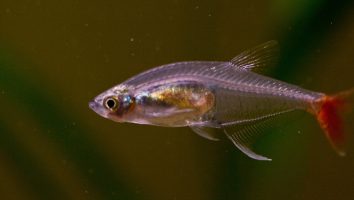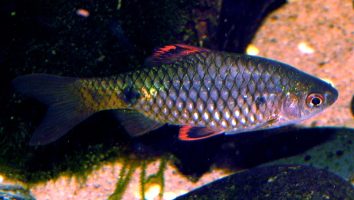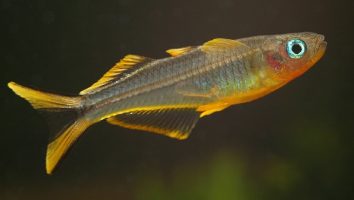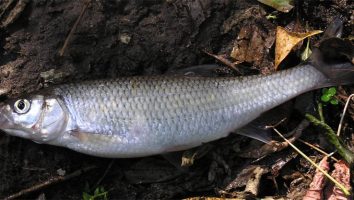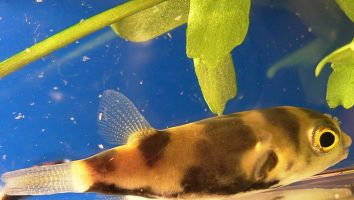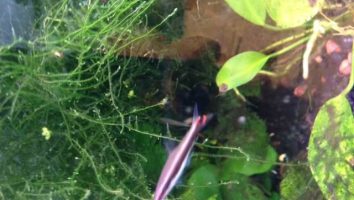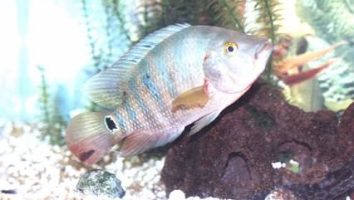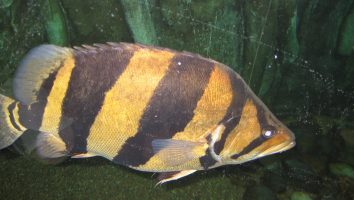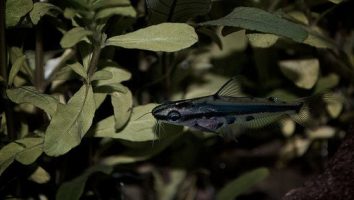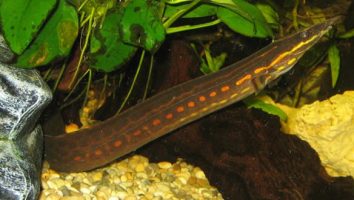The crescent betta, also known as the halfmoon betta, is a beautiful and popular freshwater fish. They’re easily recognizable by their long, flowing fins and bright colors.
This guide will teach you everything you need to know about crescent betta care. You’ll learn about their diet, tank mates, size, lifespan, and more!
Table of contents
Species overview
Crescent bettas (Betta splendens) are a type of freshwater fish that is native to Thailand, Cambodia, and Vietnam. They are most commonly found in slow-moving waters with a lot of vegetation.
The crescent betta gets its name from the distinct crescent-shaped tail that is found on males of the species. This tail is used for both territorial displays and also for attracting mates.
The crescent betta is a very popular aquarium fish due to its bright colors and beautiful tail. They are also relatively easy to care for, which makes them a good choice for beginner aquarium hobbyists.
Appearance

The first thing you’ll notice about this species is their long, flowing fins. The fins on males are significantly longer than those on females. In fact, the fins on males can extend up to twice the length of their bodies!
The fins on females are still rather lengthy, but they don’t compare to the size of those on males.
The body shape of these fish is very similar to that of a Halfmoon betta. They have a long and slender body with a small head. The difference is that Crescent bettas have a little bit more of a curved shape to them.
The base color of these fish is typically a deep blue. However, there is a lot of variation when it comes to the patterns and colors on their fins. You’ll find that some have more red, some have more yellow, and some have a mix of both.
The patterns on their fins can be stripes, spots, or a combination of both. There is a lot of variation in this department as well!
Lifespan
The average lifespan of a Crescent betta is 2 to 3 years. There are a number of factors that impact their life expectancy.
For starters. if these fish haven’t reproduced then their lifespan will usually be on the higher side of this range. That process can really take a toll on the fish.
The general level of care they receive obviously matters a great deal as well. Even though these are very hardy fish, they’ll obviously live longer in optimal conditions.
Size
The crescent betta, also known as the halfmoon betta, is one of the most popular varieties of bettas. They get their name from their large, flared fins that look like a crescent moon. Crescent bettas typically grow to be about 2.5 inches long.
Tank
Tank Size
The minimum tank size for a Crescent betta is 5 gallons. If you’re looking for a freshwater fish that can fit in an average-sized tank, this is not the fish for you.
If you want to keep two Crescent bettas in the same tank you’ll want to add at least another 5 gallons to that minimum number if you want them to thrive.
Another reason why you need to provide enough space is for the sake of enrichment and comfort. These fish like to roam and will often run gentle but steady laps around your tank. Giving them a little bit of extra space can go a long way in making sure they can comfortably turn around in the tank.
Water Parameters
The crescent betta is a peaceful freshwater fish that is perfect for the beginner fish keeper. They are very easy to care for and can live in a wide range of water conditions.
Here are a few things to keep in mind when it comes to the crescent betta’s water parameters.
- Water temperature: 72 to 80 degrees Fahrenheit
- pH levels: 6.5 to 7.5
- Water hardness: 2 to 12 dGH
- Alkalinity Levels: 4-8 dKH
What To Put In Their Tank
The Crescent Betta is a beautiful fish that is easy to care for. They are peaceful and can be kept with other fish, but should not be kept with other bettas.
When setting up their tank, you should use a fine gravel or sand substrate. They like to dig, and a coarser substrate can damage their delicate fins.
Crescent bettas also like to hide, so be sure to include plenty of hiding places in their tank. Driftwood, rocks, and plants are all good options.
You should also include a heater in their tank, as they prefer water that is on the warmer side. Aim for a temperature between 78 and 82 degrees Fahrenheit.
Finally, be sure to include a filter in their tank. They are not a particularly messy fish, but a filter will help keep the water quality high.
Common Diseases
There are a few diseases that you should be aware of if you’re keeping crescent bettas. The most common one is velvet, which is a parasitic infection that can be deadly if left untreated.
This will show itself as small, brownish-gold spots on the body and fins of your fish. If you notice this, it’s important to act fast and begin treatment immediately.
Another disease to look out for is fin rot. This is usually caused by poor water quality and can be quite serious if it’s not dealt with quickly.
The most obvious symptom of fin rot is, you guessed it, rotting fins. This can lead to your fish’s fins disintegrating entirely if it’s left untreated, so it’s definitely something you want to avoid.
As always, the best way to keep your fish healthy is to maintain a clean and stable tank. This will help to prevent a lot of diseases and illnesses before they even have a chance to start.
Behavior & Temperament
The crescent betta is a beautiful, but shy fish. They are not as social as other bettas and prefer to live alone or in groups of their own species. They are not very active and prefer to hide in plants or other objects in their tank.
These fish are not aggressive, but may nip at other fish if they feel threatened. They are peaceful fish that do not bother other tank mates.
Tank Mates
The crescent betta is a peaceful fish that can get along with most other species. However, there are a few things to consider when choosing tank mates.
First, these fish come from slow-moving waters in Southeast Asia. As a result, they prefer tank mates that don’t require a lot of water movement.
Fish that come from fast-moving waters can be too much for a crescent betta to handle.
Secondly, crescent bettas are shy and prefer to stick to their own territory. They don’t like being crowded and may become stressed if there are too many fish in the tank.
As a general rule, it’s best to add one fish per 10 gallons of water. This will give the crescent betta enough space to feel comfortable.
Some good tank mates for a crescent betta include:
- Ghost Shrimp
- Guppies
- Platies
- Neon Tetras
- Swordtails
- Mollies
Breeding
Breeding Crescent bettas is a bit more difficult than other species, but it can be done with some patience and knowledge.
The first step is to purchase a group of young fish. It’s best to start with at least six, but more is always better. That way you can be sure to get a healthy mix of males and females.
Once you have your fish, set up a breeding tank. It should be at least 10 gallons, but 20 gallons is even better. The water should be between 82 and 86 degrees Fahrenheit. You’ll also need to add a layer of peat moss to the bottom of the tank.
Now, it’s time to wait. It can take up to six months for Crescent bettas to reach maturity and be ready to breed. During that time, you must carefully monitor the water conditions.
Females are ready to spawn when they start to develop a gravid spot. This is a dark area on the abdomen that holds the eggs. When you see this, it’s time to set up the breeding tank.
Fill the tank with two to three inches of water. Then, add the female. She will lay her eggs on the peat moss. Once she’s done, remove her from the tank.
The male will then fertilize the eggs. He will also guard them until they hatch.
After about three days, the eggs will hatch. At this point, you can start to feed the fry baby brine shrimp. Continue to do this until they are large enough to eat regular food.
Conclusion
Crescent bettas are a beautiful and unique fish that make a great addition to any freshwater aquarium. They’re not the easiest fish to care for, but with a little knowledge and commitment, you can successfully keep them healthy and happy.
We hope this guide has been helpful and that you feel more prepared to take on the challenge of keeping a crescent betta. As always, if you have any questions, don’t hesitate to reach out to us. We’re always happy to help!

